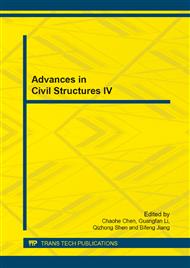p.1493
p.1498
p.1504
p.1512
p.1522
p.1531
p.1538
p.1542
p.1551
Experimental Study and Analysis of the Structural Behavior of Steel-Concrete Composite Beam after Shear Connector Corrosion
Abstract:
Stud shear connector corrosion is an important factor for the durability degradation of steel-concrete composite structures. Stud shear connector corrosion in the natural environment is a slow process, so the shear capacity of deteriorated stud shear connector was studied by accelerate d deterioration using a galvanstatic method in this paper. Then, bending tests were conducted to study the structural behavior of steel-concrete composite beam after stud shear connector corrosion. Experimental results show that with the increase of conduction time, the corrosion rate of stud increases, the shear capacity of stud as well as the flexural capacity of steel-concrete composite beam decreases and the relative bond-slip between steel beam and concrete increases when loading. By the regression analysis of experimental results, formula was proposed to predict the shear capacity of studs after corrosion and the flexural capacity of deteriorated steel-concrete composite beam.
Info:
Periodical:
Pages:
1522-1530
Citation:
Online since:
July 2014
Authors:
Price:
Сopyright:
© 2014 Trans Tech Publications Ltd. All Rights Reserved
Share:
Citation:


